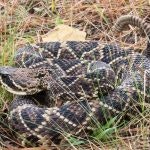Alligators and Rattlesnakes and Their Importance in Preserves


August 1, 2024 By Katie Roundtree
Northern’s preserve areas are designed to preserve and conserve native ecosystems, and the American Alligator and the Eastern Diamondback Rattlesnake are essential members of that community.
The American alligator, North America’s largest reptile, has no natural predators except humans. This species has been around for about 200 million years and has adapted to numerous changes in the Earth’s environmental conditions. Their existence was threatened when hunters began killing large numbers of these animals for their exotic meat and their supple belly skin, used to make shoes, belts, and pocketbooks. Other people considered alligators to be useless and dangerous and hunted them for sport or out of hatred. Between 1950 and 1960, hunters wiped out 90% of the alligators in Louisiana, and by the 1960s, the alligator population in the Florida Everglades was also near extinction.
Alligators are not just members of their ecosystems but keystone species that play a unique and crucial role. A keystone species is an organism that helps define an entire ecosystem. Without its keystone species, the ecosystem would be dramatically different or cease to exist altogether. Alligators, with their deep depressions, or gator holes, that collect fresh water during dry spells, serve as refuges for aquatic life, and supply fresh water and food for many animals when water is scarce, are a prime example of this. Their large nesting mounds provide nesting and feeding sites for herons and egrets. Alligators also eat large numbers of gar (a predatory fish) and thus help maintain populations of game fish such as bass and bream. They also prey on invasive species, helping the native species survive. As alligators move from gator holes to nesting mounds, they help keep areas of open water free of invading vegetation. Without these ecosystem services, freshwater ponds and shrubs and trees would fill in coastal wetlands in the alligator’s habitat, and dozens of species would disappear.
Contrary to popular belief, alligators are less aggressive than many other species of crocodylians. They have a surprisingly well-developed ability to remember things like sources of food. If they see movement in the water, they will approach the source simply because they are curious. They pose little threat to humans as they are typically not aggressive unless they feel threatened or are in danger. It’s important to respect their space and understand their behavior. This is why it is crucial for residents to stay high up on the banks or sidewalks, be aware of their surroundings, teach children to stay clear of the lakes and keep all dogs on a leash, promoting a harmonious coexistence with these fascinating creatures.
Like alligators, snakes, including rattlesnakes, are essential to our ecosystem. They help control small mammal populations such as mice, rats, and rabbits. Rattlesnakes can also help disperse seeds because their digestive systems don’t have the enzymes to break down certain foods. Seeds can germinate while still in their digestive system. Rattlesnakes may travel 8–10 miles before passing the seeds through their system. The Eastern Diamondback Rattlesnake is a native snake in decline in much of its native range and could soon see federal protections under the Endangered Species Act. They pose little threat to humans as they are typically not aggressive unless threatened or in danger.
As conservationists, we know all species are connected and equally valuable to a healthy ecosystem. Our job is to preserve as many species as possible and develop a sense of shared responsibility to keep this planet at least the same, if not better than it was left to us.
